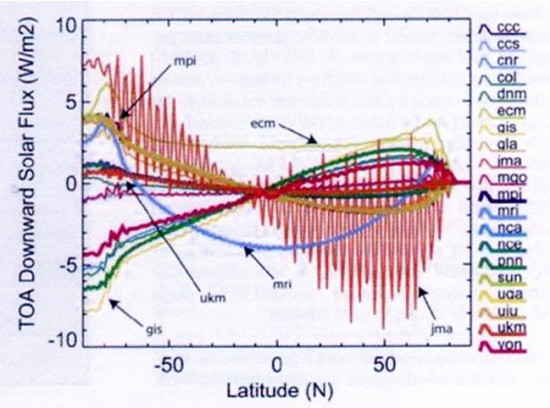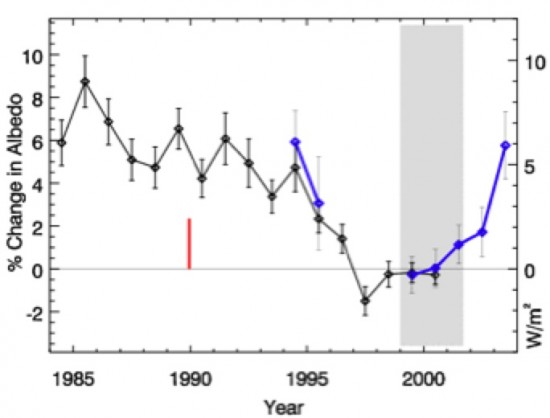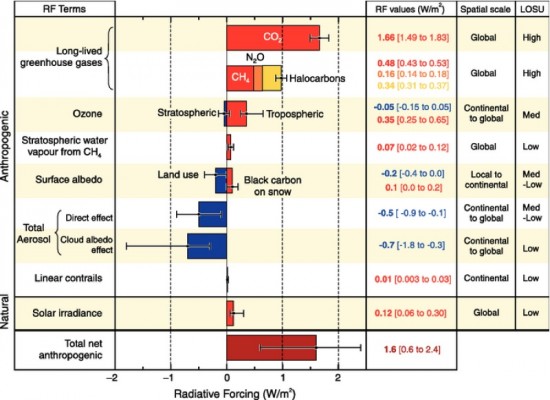
Moonlight is not light generated by the moon, but reflected sunlight. First astronauts on the moon were amazed by the brightness of Earth when it appeared over the lunar horizon. What they saw was Earthlight, which is also reflected sunlight. It’s sunlight that does little to heat the Earth because it goes directly back out to space. The amount reflected varies with changes to the surface and atmosphere. These changes are significant yet poorly measured or understood and pushed aside by the fanatic focus on CO2. Global warming due to humans is based on the hypothesis that our addition of CO2 has changed the balance of energy entering and leaving the Earth’s atmosphere. There are a multitude of factors that can change this balance, many ignored or underplayed by climate science. They get away with this because the public is unaware.
Incoming Energy Inadequacies
It begins with measures of the amount of energy entering the Earth’s atmosphere. The Intergovernmental Panel on Climate Change (IPCC) only consider changes in the irradiance portion of incoming solar energy (insolation). They claim that up to 1950 it explained over 50 percent of
There is also no agreement about the TSI at the top of the Atmosphere (TOA). As Raschke explained, “Solar radiation is the prime source for all processes within our climate system. Its total amount, the total solar irradiance (TSI) reaching the top-of-atmosphere (TOA), and its variability are now quite accurately known on the basis of multiple satellite measurements and extremely careful calibration activities (Fröhlich and Lean, 2004).”… “Computations, therefore, should be relatively easy.“ However, he shows there is no agreement. He compared 20 models and their input values for TOA. (Figure 1) He concludes, “It can be speculated that such different meridional profiles of the solar radiative forcing at TOA should also have impact on the computed atmospheric circulation pattern, in particular when simulations over periods of several decades to several centuries are performed. Therefore, related projects within the World Climate Research Program should take appropriate steps to avoid systematic discrepancies as shown above and to estimate their possible impact on the resulting climate and circulation changes.” IPCC are projecting climate change for the next 50 years or more.
So we have problems with the amount of incoming energy, but there are more problems with what happens to the energy once it enters the atmosphere.

Figure 1: Comparison of TOA input values for 20 models.
Source: Ehrhard Raschke, University of Hamburg. 15 August 2005.
Outgoing Inadequacies
One of these is change in albedo. Some believe it’s more important than CO2 in affecting balance. “The most interesting thing here is that the albedo forcings, in watts/sq meter seem to be fairly large. Larger than that of all manmade greenhouse gases combined.”
When sunlight strikes a surface the color, texture and angle of the light (known as the angle of incidence) determines how much is reflected or absorbed. The difference between them, as a percentage, is called the albedo from the root Latin word albus for white. With a pure white shiny surface 100 percent of the light is reflected so the albedo is 100. On a matte black surface 100 percent is absorbed and the albedo is zero (Figure 2). A solar collector needs to absorb as much solar energy as possible so is matte black and set at right angles to the solar rays.

The moon’s albedo is 7, which means 93 units of 100 are absorbed and 7 units reflected. Earth’s albedo is 30 on average for the entire globe. The amount varies from a high of 75 to 95 percent for fresh snow down to 8 or 9 percent for coniferous forest. Seasonal variation in snow and ice cover is important as it affects global energy and therefore the

Figure 3: Global Albedo change1984 – 2004. Error bars due to seasonal variability of 15-20%. The red line is the IPCC estimated GHG forcing for 100 years. Source
IPCC Inadequacies
IPCC reject irradiance as a cause of temperature change since 1950, but they also reject variations in sun/earth relationships, known as the Milankovitch Effect and the relationship between sunspots and temperature hypothesized by the Svensmark Cosmic Theory. The latter shows a relationship between changes in solar magnetism evidenced by sunspots. As the magnetism varies it determines the amount of galactic cosmic radiation reaching the Earth, which creates low cloud. As low cloud varies albedo varies.
The Earthshine project of the California Institute of Technology that produced Figure 3 concluded in 2004. “Earth’s average albedo is not constant from one year to the next; it also changes over decadal timescales. The computer models currently used to study the climate system do not show such large decadal-scale variability of the albedo.” Sadly, there are many factors affecting climate change that the IPCC ignore or underplay to achieve the political result that human CO2 is the sole cause.

Figure 4: IPCC assessment of radiative forcing levels
They only acknowledge “cloud albedo effect” (Figure 4), but correctly admit their level of scientific understanding (LOSU) is low. It is low or medium low for seven of nine items. Low means 2 out of 10 confidence level, medium – low is less than 4 out of 10. They incorrectly claim a high LOSU for CO2, or 8 out of 10, but that is politically necessary.
So they ignore many variables and admit they know little about the ones they study. It is a total abrogation of scientific and social responsibility to let these results form the basis for draconian and destructive energy and environmental policies. They shouldn’t have won a Nobel Peace Prize. They couldn’t have won a Science Prize.
This article first appeared in the Canadian Free Press, August 23, 2010.


